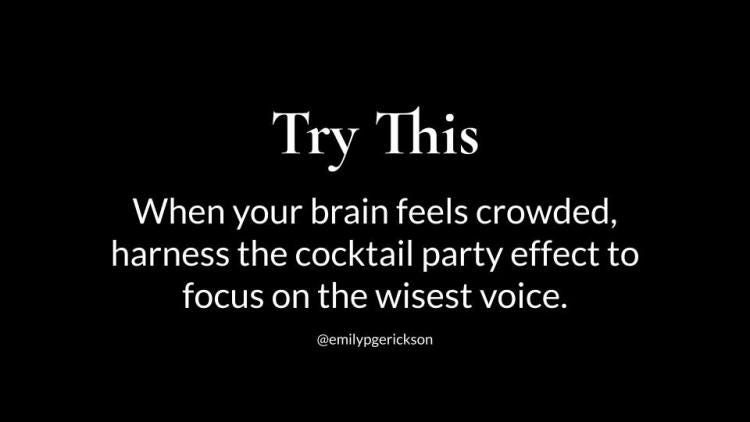The Cocktail Party In Your Head
How to Harness The Cocktail Party Effect To Help Your Mental Health
One Sunday afternoon, while walking along the river path near where I live in Saint Paul, I wandered off the pavement to a clearing where the bluffs swing out over the Mississippi. I watched the wind push a pocket of snow from its perch in an oak to the cold ground below. During its ethereal descent through a slant of sunlight, the snow sparkled.
In the wintertime, a serene stillness settles over the land. My brain, however, doesn’t get the memo. When everything outside of me is quiet, inside my mind’s chatter revs up.
The voices berate me and repeat themselves incessantly. Frankly, they’re downright rude. The details are boring. They feature my personal bugaboos, namely that I’m a failure with all the ubiquitous castigation that implies. It can be uncomfortably crowded in my head.
But if my head were a room and there indeed was a crowd in it, it might not be quite so bad. Why? The cocktail party effect. The cocktail party effect is the psychological phenomenon whereby people selectively attend to particular auditory stimuli and ignore others, as at the eponymous cocktail party (remember those?). Like a biological mute button.
When I made this connection recently, I decided to see if it could apply the cocktail party effect internally. I was surprised by what I found.
I began by noticing the different thoughts in my head. Then I practiced tuning in to specific thoughts while letting others fade into the background. This practice, which reminded me of Vipassana meditation, was helpful in itself. Turning up the volume on one stream of thoughts at a time reduced the sense of claustrophobia I’d been feeling. Then I began to notice a pattern.
When I examined the content of my thoughts one by one, I learned that for me, one of my first thoughts is often the wisest. The rest are frequently an attempt to muscle my way toward logical narrative coherence, which sometimes fails to account for important information for which I don’t yet have words. This order makes sense because our intuition is better positioned to synthesize many everyday situations than we tend to appreciate in these data-driven, analytical times. The kicker is that the situations I don’t have words for yet are often the ones on which I tend to ruminate. In other words, the situations most likely to draw a cognitive crowd are the times I could benefit most from muzzling the mob.
Noticing this pattern has freed me to apply the cocktail party effect to even greater benefit. When the crowd in my head begins to feel overwhelming, I ask myself: Who do I want to hear from right now? There are many people here, and I won’t be able to speak to everyone at the party. I have to choose. That question — that reality check — creates a little breathing room. It also highlights the truth: While I can’t choose all my thoughts, I can choose which I pay attention to.
When I ask myself who I want to hear from, most of the time, my answer is my wisest self. Now that I know she tends to arrive early, I can seek her out right away. If another voice tries to grab my attention, I can say: I’m not available right now. I’m speaking with her. Then I can lock eyes with my wisest self and hear what she has to say.
When I take time to listen — really listen — I feel better. I feel settled. I feel still. I feel something like that snowy scene I encountered by the Mississippi.





